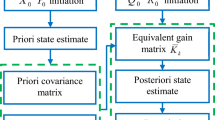Abstract
A dual-rate Kalman Filter (DRKF) has been developed to integrate the time-differenced GPS carrier phases and the GPS pseudoranges with INS measurements. The time-differenced GPS carrier phases, which have low noise and millimeter measurement precision, are integrated with INS measurements using a Kalman Filter with high update rates to improve the performance of the integrated system. Since the time-differenced GPS carrier phases are only relative measurements, when integrated with INS, the position error of the integrated system will accumulate over time. Therefore, the GPS pseudoranges are also incorporated into the integrated system using a Kalman Filter with a low update rate to control the accumulation of system errors. Experimental tests have shown that this design, compared to a conventional design using a single Kalman Filter, reduces the coasting error by two-thirds for a medium coasting time of 30 s, and the position, velocity, and attitude errors by at least one-half for a 45-min field navigation experiment.













Similar content being viewed by others
References
Banville S, Langley RB (2009) Improving real-time kinematic PPP with instantaneous cycle-slip correction. ION GNSS 2009, Savannah, Georgia, USA, pp 2470–2478
Benson DO (1975) Comparison of two approaches to pure-inertial and Doppler-inertial error analysis. IEEE Trans Aerosp Electron Syst 11(4):447–455
Farrell JL (2001) Carrier phase processing without integers. ION 57th Annual Meeting, Albuquerque, NM, USA
Farrell JL (2006) Velocity and acceleration from unaided carrier phase. IEEE/ION PLANS 2006, Coronado, CA, USA
Gebre-Egziabher D, Wang J (1998) Gravity modeling for high-accuracy GPS/INS integration. Navigation 45(3):209–220
Goshen-Meskin D, Bar-Itzhack IY (1992) Unified approach to inertial navigation system error modeling. J Guid Control Dyn 15(3):648–653
GPS SPS PS (2008) Global positioning system standard positioning service performance standard, 4th edn. DoD Official Document, Washington, pp 21–22
Graas FV, Soloviev A (2004) Precise velocity estimation using a stand-alone GPS receiver. Navigation 51(4):283–292
Grewal MS, Weill LR, Andrews AP (2007) Global positioning systems, inertial navigation, and integration, 2nd edn. Wiley, New York, pp 382–424
Groves PD (2008) Principles of GNSS, inertial, and multisensor integrated navigation systems, 3rd edn. Artech House, London, pp 363–406
Han S, Wang J (2008) Monitoring the degree of observability in integrated GPS/INS systems. In: International symposium on GPS/GNSS 2008, Tokyo, Japan, pp 414–421
Han S, Wang J (2010) Land vehicle navigation with the integration of GPS and reduced INS: performance improvement with velocity aiding. J Navig 63(1):153–166
IS-GPS-200D (2006) Navistar global positioning system interface specification. Navstar GPS Joint Program Office, El Segundo, p 84
Jekeli C (1997) The effect of earth’s gravity on precise short-term, 3-D free-inertial navigation. Navigation 44(3):347–357
Misra P, Enge PK (2001) The global positioning system: signals, measurements, and performance. Ganga-Jamuna Press, Lincoln, pp 153–155, 161–170, 175–250
Niu X, El-Sheimy N (2005) The development of a low-cost MEMS IMU/GPS navigation system for land vehicles using auxiliary velocity updates in the body frame. ION GNSS 2005, Long Beach, CA, USA, pp 13–16
Savage PG (1998) Strapdown inertial navigation integration algorithm design part 1: attitude algorithms. J Guid Control Dyn 21(1):19–28
Savage P (2000) Strapdown analytics. Strapdown Associates, MN, pp 3-76–3-86
Wang J, Stewart MP, Tsakiri M (1998) A discrimination test procedure for ambiguity resolution on the fly. J Geodesy 72(11):644–653
Wang J, Stewart MP, Tsakiri M (2000) A comparative study of the integer ambiguity validation procedures. Earth Planets Space 52(10):813–817
Wang J, Lee HK, Hewitson S et al (2003) Influence of dynamics and trajectory on integrated GPS/INS navigation performance. J Glob Position Syst 2(2):109–116
Wendel J, Trommer GF (2004) Tightly coupled GPS/INS integration for missile applications. Aerosp Sci Technol 8(7):627–634
Wendel J, Monikes R, Trommer GF (2006) Time-differenced carrier phase measurements for tightly coupled GPS/INS integration. IEEE/ION PLANS 2006, Coronado, CA, USA
Zheng G, Gebre-Egziabher D (2009) Enhancing ambiguity resolution performance using attitude determination constraints. ION GNSS 2009, Savannah, GA, USA, pp 2156–2168
Acknowledgments
The first author would like to show his appreciation to Chinese Scholarship Council for supporting his PhD study at the University of New South Wales (UNSW) in Australia. The authors also would like to thank Dr. Weidong Ding, Mr. Ali Almagbile, and Mr. Nathan Knight in the School of Surveying and Spatial Information Systems at UNSW, for their help during the experimental tests.
Author information
Authors and Affiliations
Corresponding author
Rights and permissions
About this article
Cite this article
Han, S., Wang, J. Integrated GPS/INS navigation system with dual-rate Kalman Filter. GPS Solut 16, 389–404 (2012). https://doi.org/10.1007/s10291-011-0240-x
Received:
Accepted:
Published:
Issue Date:
DOI: https://doi.org/10.1007/s10291-011-0240-x




